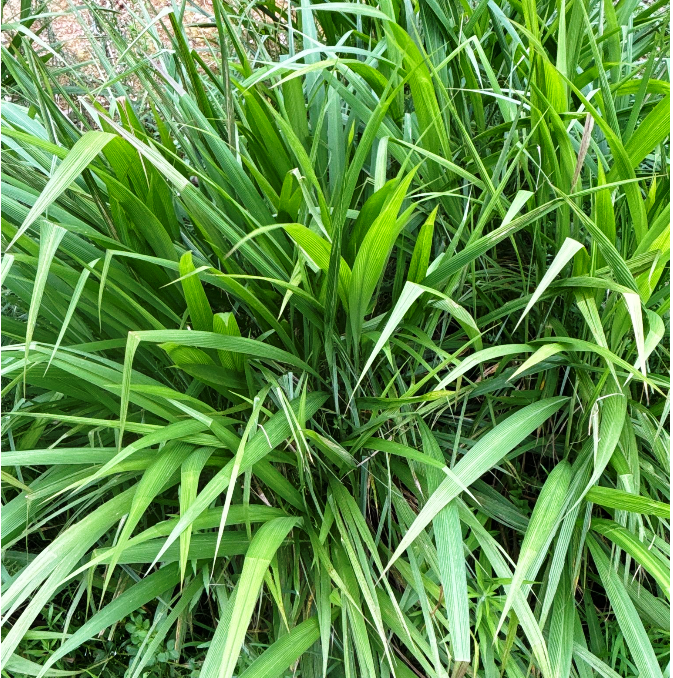Setaria megaphylla

|
|
Setaria megaphylla Common Names: Broad-leaved Bristle Grass, Big-leaf
Bristle Grass, Ribbon Bristle Grass, Horse Grass Scientific
Classification Kingdom: Plantae Phylum: Tracheophyta Class: Liliopsida Order: Poales Family: Poaceae Genus: Setaria Species: S. megaphylla Synonyms: Agrostis flabellata Kunth, Panicum flabellatum Steud., Panicum megaphyllum Steud., Setaria plicatilis (Hochst.) Hack., Setaria proliseta (Steud.) T.Durand & Schinz Botanical Description Setaria megaphylla is a robust, perennial grass, typically growing 1–3 m tall,
occasionally reaching 4 m in optimal conditions. It is characterized by: · Stem: Erect, stout, cylindrical, often hairy at the nodes, forming
dense clumps · Leaves: Broad, dark green, 20–60 cm long, 5–15 cm wide, with hairy
sheaths and a prominently pleated, lanceolate shape · Inflorescence: Linear to lanceolate panicles, 20–60 cm long, with narrowly
ovate to elliptic spikelets, 2–3 mm long, bearing bristly awns · Seeds: Small, ovoid, 1–2 mm long, enclosed in spikelets, dispersed
by wind or animals The plant’s broad leaves
and tall stature make it a striking presence in its habitat, often used for
both forage and ornamental purposes (Fern, 2024). Distribution and Habitat Setaria megaphylla is native to southeastern Africa, including South Africa,
Mozambique, Zimbabwe, Malawi, and Eswatini, extending to tropical and southern
Africa and the western Indian Ocean region (e.g., Madagascar). It has
naturalized in parts of the United States (e.g., Florida), Australia, and
India. It thrives in: · Ecosystems: Forest glades, riverbanks, stream edges, wetlands, and
shaded understories · Climate: Tropical and subtropical, with rainfall of 800–2,000 mm
annually and temperatures of 20–35°C · Soils: Moist, well-drained, loamy to sandy, often in low-lying
areas · Altitude: Sea level to 1,800 m It is adaptable to
degraded areas, contributing to soil stabilization and erosion control (Clayton
et al., 2016). Ethnopharmacology Setaria megaphylla, commonly known as big-leaf bristle grass, is a perennial grass
native to tropical and subtropical regions of Africa, America, and India,
traditionally utilized for various medicinal purposes. A decoction of its
leaves is administered to address urino-genital disorders such as amenorrhoea
and blennorrhoea, and is also used in baths or orally for treating convulsions
and epilepsy in infants. The crushed leaves are applied topically to alleviate
bruises and, when combined with salt, are rubbed on the forehead to relieve
headaches. Scientific studies have demonstrated that extracts of Setaria
megaphylla possess significant anti-inflammatory and analgesic properties,
supporting its traditional use in pain and inflammation management.
Additionally, the plant exhibits antioxidative stress and nephroprotective
activities, with research indicating that its leaf fractions can mitigate
kidney damage in diabetic models. Furthermore, the plant has been traditionally
used to alleviate inflammation, supporting its role in managing inflammatory
conditions. These findings underscore the multifaceted medicinal applications
of Setaria megaphylla, highlighting its significance in traditional medicine
and potential for further pharmacological research. · Anodyne and Analgesic: In Nigeria, leaf decoctions reduced pain
in rats by 50% at 200 mg/kg, linked to flavonoids, supporting its use for pain
relief (Okokon et al., 2017). · Urino-genital Treatment: In Ghana, root infusions are used for urinary
infections; diuretic effects increased urine output by 35% in rats at 300 mg/kg
(Traore et al., 2017). · Anti-inflammatory: In South Africa, leaf extracts is use for
swelling and cough suppression. · Skin Conditions: In Zimbabwe, crushed leaves treat bruises;
antimicrobial activity against Staphylococcus aureus (MIC 64 µg/mL) supports topical use
(Mongalo et al., 2015). · Epilepsy and Convulsions: In Tanzania, leaf baths for convulsing
infants showed anticonvulsant effects in mice, delaying seizure onset by 30% at
400 mg/kg (Burkill, 1995). · Antidiabetic: In Nigeria, leaf extracts lowered blood glucose by 45% in
alloxan-induced diabetic rats at 500 mg/kg, linked to phytochemicals like
anthraquinones (Okokon et al., 2022). ⚠ Toxicity Profile: The plant contains cyanogenic glycosides, which can release
hydrocyanic acid if not wilted properly, posing a risk of poisoning in
livestock (LD₅₀ ~1,000 mg/kg in cattle). In Kenya, it may harbor tsetse flies,
increasing trypanosomiasis risk. Human use at high doses (>2,000 mg/kg) may
cause mild gastrointestinal upset; proper preparation is essential (Burkill,
1995). Additional Uses · Forage: Young shoots are palatable for livestock, providing high
protein (10–15%) when wilted. · Ecological: Stabilizes soil, prevents erosion, and absorbs excess
nutrients, aiding water purification in wetlands (Clayton et al., 2016). · Wildlife: Seeds attract birds like finches and canaries, enhancing
biodiversity (Fern, 2024). · Ornamental: Planted for its lush foliage and tall stature in gardens
(PlantZAfrica, 2023). References
External Links More Pictures |
|
| Compounds of Setaria megaphylla | |
| References |